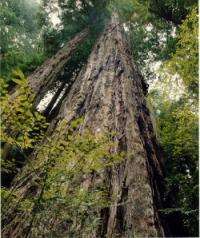If a Tree Falls in the Forest...

(PhysOrg.com) -- In a century of increasing forest fires, hurricanes and plagues, Dr. Ben Bond-Lamberty, a terrestrial ecologist for the Pacific Northwest National Laboratory, suggests taking a fresh look at modeling carbon's impact on the biosphere. During his presentation at the 2009 American Geophysical Union fall meeting last month, Bond-Lamberty encouraged carbon modelers to account for considerable ecosystem changes and reconsider some outdated assumptions in their constant pursuit of more accurate carbon modeling.
Bond-Lamberty roughly estimates that many models predicting global carbon input and output could be off by three to 10 percent. Carbon modeling examines what happens when plants die and carbon is released back into the atmosphere. But if more plants die than usual, such as when trees are knocked down by a hurricane or destroyed by a plague of insects, the cycle can shift.
For example, the average annual number of wildfires has increased four-fold in the Western United States, according to a Scripps Institute of Oceanography report. About twice as many Atlantic hurricanes form each year on average than did a century ago, according to the National Center for Atmospheric Research. And British Columbia, Canada, has lost at least 33 million acres of pine forest because of the unprecedented mountain pine beetle outbreak, the New York Times reported last year.
The sky is falling? Not yet, but this increase natural disasters, plus human-caused disturbances like land-use changes, makes it increasingly challenging to predict the planet's cycle of carbon, the main component of climate-altering greenhouse gases.
Challenging as it is, accurately modeling the carbon cycle is critical when trying to understand and predict the human impact on the biosphere.
When scientists first developed carbon models in the late 1970s and early 1980s, they assumed the Earth's ecosystems would remain fairly stable. But that's increasingly not the case. Many carbon models aren't adjusted for disturbances like natural disasters, logging, and land-use changes. As a result, Ben Bond-Lamberty is actively advocating the need to update carbon modeling to further reduce uncertainties.
Over the last decade, more scientists have started adding disturbances into their carbon models, particularly regional models, but this isn't a standardized practice. Most global models don't account for such changes yet, Bond-Lamberty said. He's trying to change that.
"As world leaders consider their climate and carbon policies, scientists have a responsibility to provide them the best available data. Getting that reliable data isn't easy, but I'm confident ecosystem modelers are up for the challenge," said Bond-Lamberty.
Studies will be expanded to include ecosystem-specific carbon density values and extent wildfire records to calculate a more accurate estimate of woody debris carbon fluxes on a continental scale. Portions of Bond-Lamberty's presentation will be presented in a forthcoming review paper currently being written as part of the North American Carbon Program's Disturbance Synthesis Activity, where Bond-Lamberty writes in collaboration with Dr. Mark Harmon of Oregon State University, Dr. Rodrigo Vargas of University of California, Berkeley, and Jianwu Tang of the Marine Biological Laboratory. The paper will be submitted to the Journal of Geophysical Research.
This research was funded by the PNNL Laboratory Directed Research and Development program.
More information: B.P. Bond-Lamberty, "Challenges (and annoyances) in modeling disturbance effects on terrestrial carbon cycling." Dec. 18, 2009. Presentation at 2009 AGU Conference, San Francisco, Calif.
Provided by Pacific Northwest National Laboratory
















